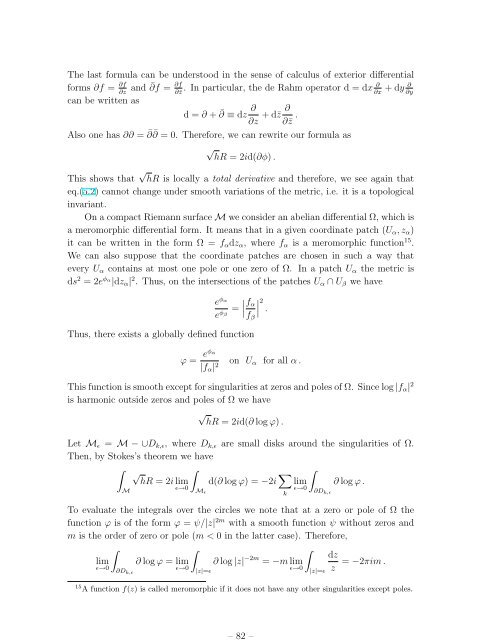Lectures on String Theory
Lectures on String Theory
Lectures on String Theory
You also want an ePaper? Increase the reach of your titles
YUMPU automatically turns print PDFs into web optimized ePapers that Google loves.
– 82 –<br />
The last formula can be understood in the sense of calculus of exterior differential<br />
forms ∂f = ∂f and ¯∂f = ∂f<br />
∂<br />
. In particular, the de Rahm operator d = dx + dy ∂ ∂z ∂¯z ∂x ∂y<br />
can be written as<br />
d = ∂ + ¯∂ ≡ dz ∂ ∂z + d¯z ∂ ∂¯z .<br />
Also <strong>on</strong>e has ∂∂ = ¯∂ ¯∂ = 0. Therefore, we can rewrite our formula as<br />
√<br />
hR = 2id(∂φ) .<br />
This shows that √ hR is locally a total derivative and therefore, we see again that<br />
eq.(5.2) cannot change under smooth variati<strong>on</strong>s of the metric, i.e. it is a topological<br />
invariant.<br />
On a compact Riemann surface M we c<strong>on</strong>sider an abelian differential Ω, which is<br />
a meromorphic differential form. It means that in a given coordinate patch (U α , z α )<br />
it can be written in the form Ω = f α dz α , where f α is a meromorphic functi<strong>on</strong> 15 .<br />
We can also suppose that the coordinate patches are chosen in such a way that<br />
every U α c<strong>on</strong>tains at most <strong>on</strong>e pole or <strong>on</strong>e zero of Ω. In a patch U α the metric is<br />
ds 2 = 2e φ α<br />
|dz α | 2 . Thus, <strong>on</strong> the intersecti<strong>on</strong>s of the patches U α ∩ U β we have<br />
e φ α<br />
e φ β<br />
= ∣ ∣∣ f α<br />
f β<br />
∣ ∣∣<br />
2<br />
.<br />
Thus, there exists a globally defined functi<strong>on</strong><br />
ϕ = eφ α<br />
|f α | 2 <strong>on</strong> U α for all α .<br />
This functi<strong>on</strong> is smooth except for singularities at zeros and poles of Ω. Since log |f α | 2<br />
is harm<strong>on</strong>ic outside zeros and poles of Ω we have<br />
√<br />
hR = 2id(∂ log ϕ) .<br />
Let M ɛ = M − ∪D k,ɛ , where D k,ɛ are small disks around the singularities of Ω.<br />
Then, by Stokes’s theorem we have<br />
∫<br />
M<br />
√<br />
∫<br />
hR = 2i lim d(∂ log ϕ) = −2i ∑<br />
ɛ→0<br />
M ɛ k<br />
∫<br />
lim ∂ log ϕ .<br />
ɛ→0<br />
∂D k,ɛ<br />
To evaluate the integrals over the circles we note that at a zero or pole of Ω the<br />
functi<strong>on</strong> ϕ is of the form ϕ = ψ/|z| 2m with a smooth functi<strong>on</strong> ψ without zeros and<br />
m is the order of zero or pole (m < 0 in the latter case). Therefore,<br />
∫<br />
lim ∂ log ϕ = lim ∂ log |z|<br />
ɛ→0<br />
∂D ɛ→0 k,ɛ<br />
∫|z|=ɛ<br />
−2m dz<br />
= −m lim<br />
ɛ→0<br />
∫|z|=ɛ z = −2πim .<br />
15 A functi<strong>on</strong> f(z) is called meromorphic if it does not have any other singularities except poles.

















